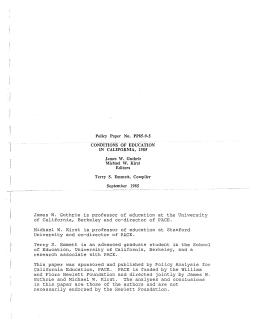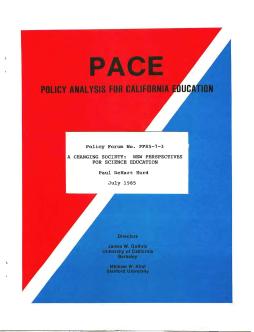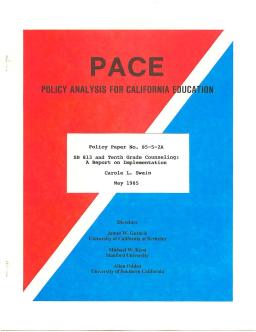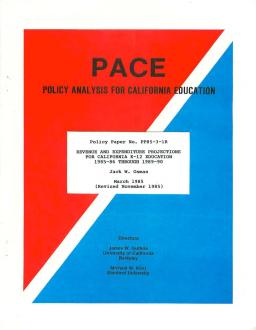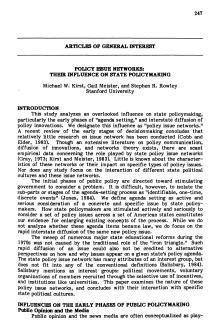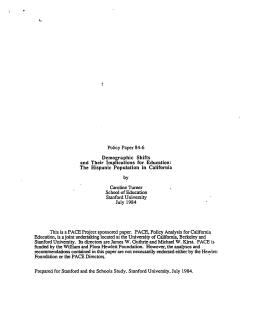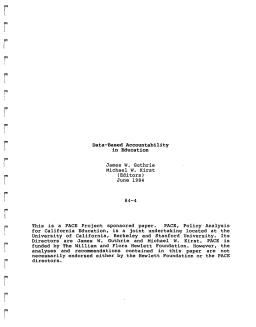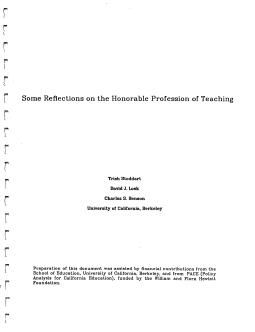Published
Summary
This technical report provides an overview of California's educational system, intended for educators, public officials, journalists, and informed citizens. With over four million students and a $17 billion annual cost, the state's school system is vast and complex. The report offers comparisons of California's education system to itself in prior years and other states, revealing patterns of change and suggesting future trends. These trends serve as a guide for the many facts and figures presented in the report.
1982–83 to 1984–85
Published
Summary
This study examines curricular changes in California high schools from 1982-85, as educational reforms aimed to enhance academic rigor. Findings show increased offerings in academic subjects like math, science, and advanced placement, and decreased offerings in areas such as industrial arts, home economics, and business education. The data aligns with statewide curricular changes, likely influenced by mandates for more extensive graduation requirements and alterations to university entrance requirements.
New Perspectives for Science Education
Published
Summary
Science education is crucial for the nation's future, but the curriculum needs to be updated to keep pace with scientific advances and changes in society. The classical image of science has changed, and science education must now be taught in a social context with an emphasis on critical thinking and responsible decision-making. Efforts to improve science education need a conceptual framework that justifies the need for change and provides direction. A new vision is required to transform science education and improve scientific and technological literacy.
A Report on Implementation
Published
Summary
Comprehensive school guidance programs attempt to address a range of student needs on personal, social, career, and academic dimensions. Many guidance and counseling programs, however, have suffered cutbacks in recent years even though students continue to be in need of guidance, and students themselves have expressed a desire for assistance.
1985–86 Through 1989–90
Published
Summary
Expenditures for elementary and secondary education in California must rise by about 59 percent between 1983–84 and the end of the decade just to maintain the status quo in terms of real per-student spending. This would amount to a K–12 budget in 1989–90 of $21.9 billion. Yet K–12 revenues are projected to grow by only 50 percent (under one scenario) or by about 72 percent (under another). In other words, unless the revenue structure is significantly altered, projected school revenues through 1990 will be inadequate to maintain the same level of spending per student or will increase at a pace...
Their Influence on State Policy Making
Published
Summary
This report analyzes the role of policy issue networks in early state policymaking stages and interstate diffusion of policy innovations. It defines agenda setting as active and serious consideration of a specific issue by state policymakers and investigates how state policymakers are stimulated to consider policy issues across the U.S. The authors further examine the nature of policy issue networks and their interaction with specific state political cultures, providing insights into the rapid interstate diffusion of new policy issues in the 1970s.
Published
Summary
This study examines consolidation's impact on student achievement in California. It finds that consolidation leads to improved educational opportunities and cost savings. Consolidation benefits low-income and minority students and has a greater impact in rural areas. Although drawbacks exist, consolidation can be an effective strategy for enhancing education. These findings offer valuable insights for policymakers and education leaders seeking to improve student outcomes in their districts.
The Hispanic Population in California
Published
Summary
The impact of school-based management plans on student achievement in California is examined with a focus on Hispanic students. Demographic data on Hispanics in California is reviewed to highlight problems with defining and counting the Hispanic population. School-based management plans can have a positive impact on student achievement, particularly for Hispanic students, but their effectiveness depends on several factors. This report emphasizes the need for careful planning and equitable distribution of resources to support their implementation.
Published
Summary
This report explores the role of accountability in school improvement and its potential drawbacks. While accountability can provide feedback, reorient action, and justify action, it can also lead to gross distortions and may not sufficiently incentivize teachers. The authors argue for a consensual view of the teacher's role and for parsimonious accountability schemes that enhance the quality of life among teachers. They propose design considerations that can improve the effectiveness of testing and controls to enhance the teaching profession.
Published
Summary
The first in a series of annual reports on education in California aims to assess school performance objectively. It summarizes data on demography, academic performance, curriculum, personnel, and finances. Highlighting California's 1983 education reform effort, the report provides a baseline for assessing future reforms, with successive reports addressing the same dimensions. It focuses on K-12 public schools but also includes some data on nonpublic and postsecondary education.
Published
Summary
California is at a critical juncture in education, needing up to 190,000 new teachers by 1991 and replacing 75% of the teaching force. Recommendations to improve teaching quality are proposed in this paper, focusing on changes in certification, professional training, and career structure. The state has the opportunity to ensure quality education for the 77 million students who will be taught by these new teachers.
